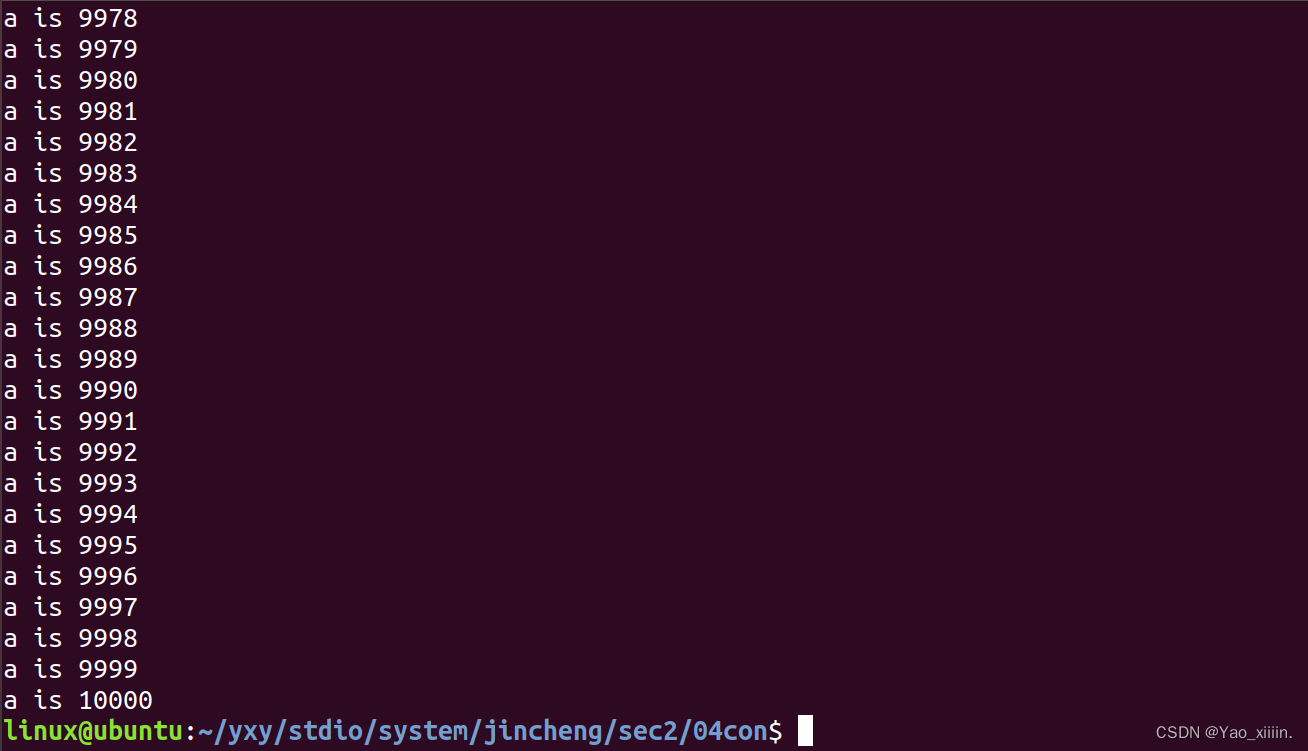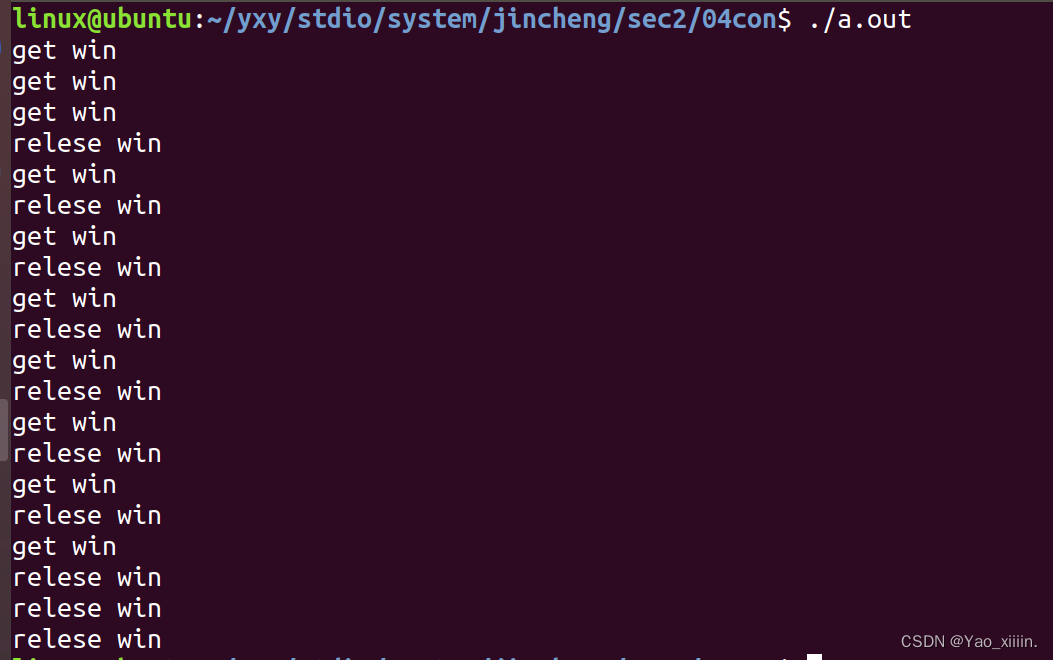一、互斥
概念:
互斥 ===》在多线程中对 临界资源 的 排他性访问。
互斥机制 ===》互斥锁 ===》保证临界资源的访问控制。
pthread_mutex_t mutex;
互斥锁类型 互斥锁变量 内核对象
框架:
定义互斥锁 ==》初始化锁 ==》加锁 ==》解锁 ==》销毁
**** *** ***
1、定义
pthread_mutex_t mutex;
2、初始化锁
int pthread_mutex_init(pthread_mutex_t *mutex,const pthread_mutexattr_t *attr);
功能:将已经定义好的互斥锁初始化。
参数:mutex 要初始化的互斥锁
atrr 初始化的值,一般是NULL表示默认锁
返回值:成功 0
失败 非零
3、加锁
int pthread_mutex_lock(pthread_mutex_t *mutex);
功能:用指定的互斥锁开始加锁代码
加锁后的代码 到 解锁部分的代码 属于 原子操作(计算机中不可再分割的操作),
在加锁期间 其他进程/线程 都不能 操作该部分代码
如果该函数在执行的时候,mutex已经被其他部分使用 则 代码阻塞。
参数: mutex 用来给代码加锁的互斥锁
返回值:成功 0
失败 非零
4、解锁
int pthread_mutex_unlock(pthread_mutex_t *mutex);
功能:将指定的互斥锁解锁。
解锁之后代码不再排他访问,一般加锁解锁同时出现。(尽量上锁解锁的代码短一些,保护并发性)
参数:mutex 用来解锁的互斥锁
返回值:成功 0
失败 非零
5、销毁
int pthread_mutex_destroy(pthread_mutex_t *mutex);
功能:使用互斥锁完毕后需要销毁互斥锁
参数:mutex 要销毁的互斥锁
返回值:成功 0
失败 非零
#include <stdio.h>
#include <stdlib.h>
#include <unistd.h>
#include <string.h>
#include <pthread.h>int a = 0;
pthread_mutex_t mutex;
void* th(void* arg)
{// pthread_mutex_lock(&mutex);int i =5000;while(i--){pthread_mutex_lock(&mutex);int tmp = a;printf("a is %d\n",tmp+1);a = tmp+1;pthread_mutex_unlock(&mutex); }// pthread_mutex_unlock(&mutex); return NULL;
}int main(int argc, char *argv[])
{pthread_t tid1,tid2;pthread_mutex_init(&mutex,NULL);pthread_create(&tid1,NULL,th,NULL);pthread_create(&tid2,NULL,th,NULL);pthread_join(tid1,NULL);pthread_join(tid2,NULL);pthread_mutex_destroy(&mutex);return 0;
}
6、trylock
int pthread_mutex_trylock(pthread_mutex_t *mutex);
功能:类似加锁函数效果,唯一区别就是不阻塞。
参数:mutex 用来加锁的互斥锁
返回值:成功 0
失败 非零
E_AGAIN
综合练习:10个人去三个窗口办业务,办完一个人才能开始办下一个人
#include <stdio.h>
#include <stdlib.h>
#include <unistd.h>
#include <string.h>
#include <pthread.h>
pthread_mutex_t mutex;
int WIN = 3;
void* th(void* arg)
{while(1){pthread_mutex_lock(&mutex);if(WIN>0){WIN--;pthread_mutex_unlock(&mutex);printf("get win\n");sleep(rand()%5);printf("relese win\n");pthread_mutex_lock(&mutex);WIN++;pthread_mutex_unlock(&mutex);break;}else {pthread_mutex_unlock(&mutex);}}return NULL;
}int main(int argc, char *argv[])
{pthread_t tid[10];int i = 0 ;pthread_mutex_init(&mutex,NULL);for(i = 0 ;i<10;i++){pthread_create(&tid[i],NULL,th,NULL);}for(i = 0 ;i<10;i++){pthread_join(tid[i],NULL);}pthread_mutex_destroy(&mutex);return 0;
}
二、同步
同步 ===》有一定先后顺序的对资源的排他性访问。
原因:互斥锁可以控制排他访问但没有次序。
linux下的线程同步 ===》信号量机制 ===》semaphore.h posix
sem_open();
信号量的分类:
1、无名信号量 ==》线程间通信
2、有名信号量 ==》进程间通信
框架:
信号量的定义 ===》信号量的初始化 ===》信号量的P(申请资源)V(释放资源)操作
===》信号量的销毁。
semaphore
1、信号量的定义
sem_t sem;
信号量的类型 信号量的变量
2、信号量的初始化
int sem_init(sem_t *sem, int pshared, unsigned int value);
功能:将已经定义好的信号量赋值。
参数:sem 要初始化的信号量
pshared = 0 ;表示线程间使用信号量
!=0 ;表示进程间使用信号量
value 信号量的初始值,一般无名信号量
都是二值信号量,0 1
0 表示红灯,进程暂停阻塞
1 表示绿灯,进程可以通过执行
返回值:成功 0
失败 -1;
3、信号量的PV 操作
P ===》申请资源===》申请一个二值信号量
V ===》释放资源===》释放一个二值信号量
P操作对应函数 ==》sem_wait();
V操作对应函数 ==》sem_post();
int sem_wait(sem_t *sem);//会阻塞
功能:判断当前sem信号量是否有资源可用。
如果sem有资源(==1),则申请该资源,程序继续运行
如果sem没有资源(==0),则线程阻塞等待,一旦有资源,则自动申请资源并继续运行程序。
注意:sem 申请资源后会自动执行 sem = sem - 1;
参数:sem 要判断的信号量资源
返回值:成功 0
失败 -1
int sem_post(sem_t *sem);
功能:函数可以将指定的sem信号量资源释放
并默认执行,sem = sem + 1;
线程在该函数上不会阻塞。
参数:sem 要释放资源的信号量
返回值:成功 0
失败 -1;
4、信号量的销毁
int sem_destroy(sem_t *sem);
功能:使用完毕将指定的信号量销毁
参数:sem要销毁的信号量
返回值:成功 0
失败 -1;
#include <stdio.h>
#include <stdlib.h>
#include <unistd.h>
#include <string.h>
#include <pthread.h>
#include <semaphore.h>
sem_t sem_C,sem_M;
void* th1(void* arg)
{int i = 5;while(i--){sem_wait(&sem_C);printf("capper ");fflush(stdout);sem_post(&sem_M);}return NULL;
}
void* th2(void* arg)
{int i = 5;while(i--){sem_wait(&sem_M);printf("made in future\n");sleep(1);sem_post(&sem_C);}return NULL;
}int main(int argc, char *argv[])
{pthread_t tid1,tid2;sem_init(&sem_C,0,1);sem_init(&sem_M,0,0);pthread_create(&tid1,NULL,th1,NULL);pthread_create(&tid2,NULL,th2,NULL);pthread_join(tid1,NULL);pthread_join(tid2,NULL);sem_destroy(&sem_C);sem_destroy(&sem_M);return 0;
}
三、互斥锁和信号量的异同
同
同一时刻只有一个在走
异
1. 运行顺序--->互斥锁没有顺序;信号量有顺序
2. 锁的个数--->互斥锁只有1个锁;信号量一般大于2个锁(几个同步变量就几个锁)
3. 加锁解锁操作--->互斥锁同一个线程:同一个锁上锁解锁;信号量同一个线程不同锁:锁自己,释放下一个锁
四、死锁
1.产生死锁的原因
(1) 因为系统资源不足。
(2) 进程运行推进的顺序不合适。
(3) 资源分配不当等。
如果系统资源充足,进程的资源请求都能够得到满足,死锁出现的可能性就很低,否则
就会因争夺有限的资源而陷入死锁。其次,进程运行推进顺序与速度不同,也可能产生死锁。
2.产生死锁的四个必要条件(同时满足 产生死锁)
(1) 互斥条件:一个资源每次只能被一个进程使用。
(2) 请求与保持条件:一个进程因请求资源而阻塞时,对已获得的资源保持不放。
(3) 不剥夺条件:进程已获得的资源,在末使用完之前,不能强行剥夺。
(4) 循环等待条件:若干进程之间形成一种 头尾相接 的循环等待资源关系。
)



实现卷帘效果)










)
Runtime实时监控jvm)


